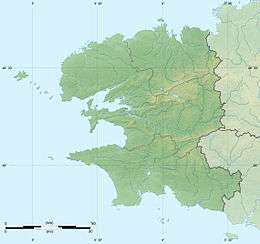Phare de Tévennec
Phare de Tévennec is a lighthouse located at the western tip of Brittany (département of Finistère), in the northern part of the Raz de Sein off the Pointe du Van. Automated in 1910 because of its difficult access, it accompanies the light of La Vieille in securing the passage of the Raz de Sein, which presents many difficulties. The rocks near Tévennec were historically known as Stevenet Banks.
 Phare de Tévennec | |
 Phare de Tévennec Location within Finistère  Phare de Tévennec Phare de Tévennec (France) | |

| |
| Location | Raz de Sein, Finistère, Brittany, France |
|---|---|
| Coordinates | 48.0714°N 4.7953°W |
| Automated | 7 February 1910 |
| Tower height | 11 metre |
| Focal height | 24 metre, 28 metre |
| Range | 12 nautical mile, 9 nautical mile, 6 nautical mile |
| Characteristic | Q WR, Fl W 4s |
| Heritage | registered historic monument |
It was listed as a monument historique by a decree of December 31st, 2015.[1]
Securing the Raz de Sein
The construction of the Ar Men lighthouse to the west, designed to secure ship navigation off the island of Sein, began in 1867. But there is also a sea passage between the île de Sein and the Pointe du Raz which constitutes a shortcut: the Raz de Sein and navigation would be protected by Tévennec.
The Tévennec light was first activated in March 1875, having a maximum range of 9 miles.
Legends
According to Jean-Christophe Fichou and Francis Dreyer, the lighthouse is said to be "one of the strangest places in the history of lighthouses," and is rumored to be haunted.[2]
During the Napoleonic Wars, the French ship Séduisant was wrecked there, resulting in the deaths of hundreds of men. The lighthouse was classified as the fourth category, requiring a single keeper and a service period of a year. A series of 23 keepers lived at the light until automation. According to legend, the first lighthouse keeper, Henri Guezennec, was driven insane by ghostly voices demanding his departure. Allegedly Guezennec’s replacement, Minou, had a similar experience. The French government then reclassified Tévennec as a two-man lighthouse however applications were rare. In 1897 the government began recruiting married couples to keep the lighthouse. Some unexplained deaths occurred. The first couple to accept the job were the Milliners. The most durable keepers, Louis and Marie-Jacquette Quéméré, followed them with their three children and a cow and remained five years. In 1907 a new couple replaced them, Msr. Roparz and his wife. More deaths occurred and a storm destroyed a part of the lighthouse while the keeper’s wife was in childbirth. Around this time the départment decided to automate the Tévennec light and service it every six months.
See also
References
- Préfecture de région Bretagne : Arrêté n° 2016-12336 du 31 décembre 2015 portant inscription au titre des monuments historiques du phare de Tévennec (Finistère)
- "Tévennec Lighthouse". Phares de France.